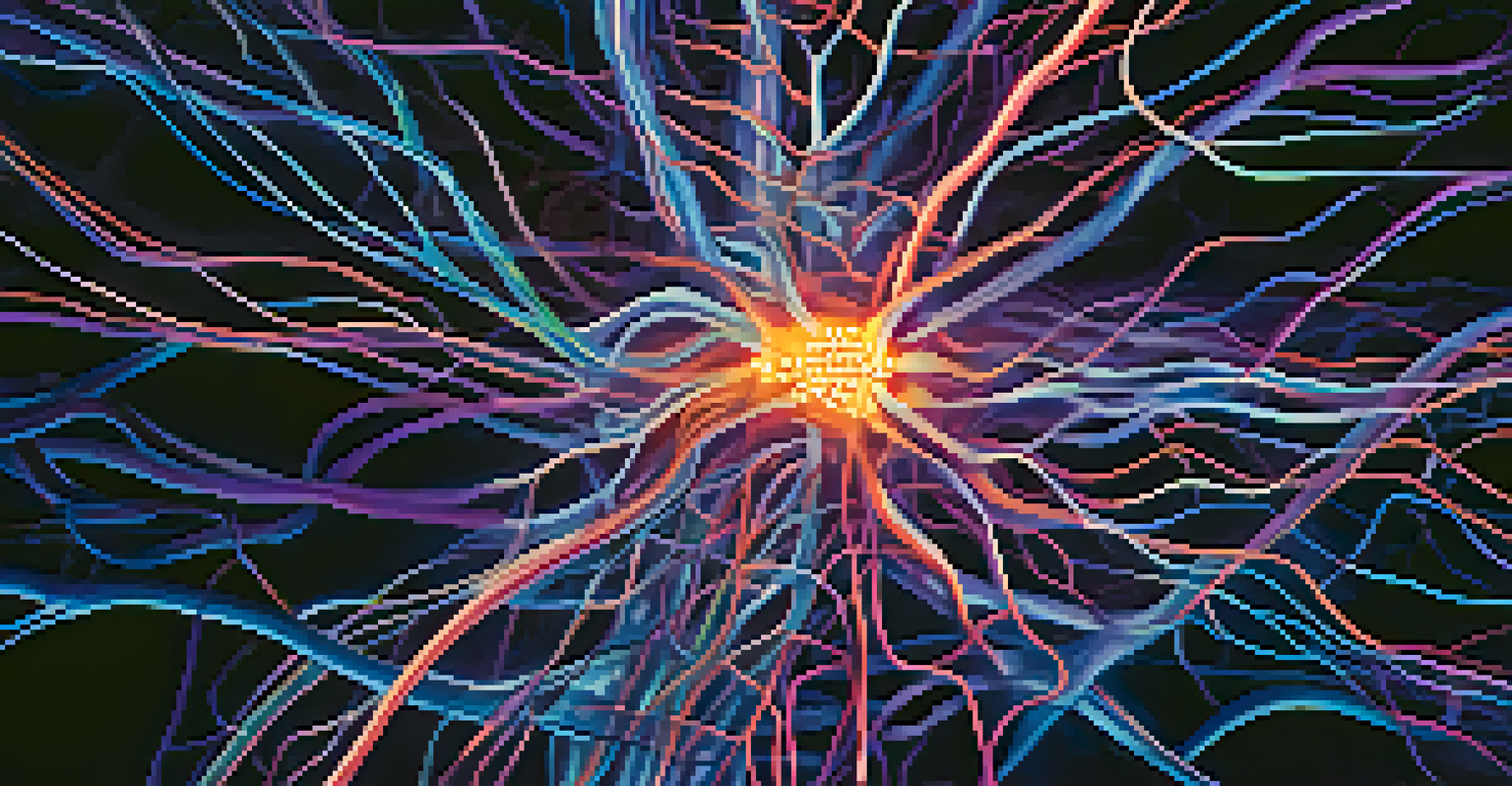Understanding the Neurological Basis of Chronic Pain

What Is Chronic Pain and Its Impact on Daily Life?
Chronic pain is defined as pain that lasts for more than three months, often persisting even after the initial injury has healed. It can significantly affect a person’s daily activities, emotional well-being, and overall quality of life. Imagine trying to enjoy a sunny day at the park while battling a relentless ache; that’s the reality for many individuals living with chronic pain.
Chronic pain is a complex and multifaceted condition that requires a comprehensive understanding of its many influences.
This type of pain can stem from various sources, including conditions like arthritis or fibromyalgia, but its true complexity lies in how the brain processes these pain signals. When the nervous system becomes hyperactive, it can lead to a situation where the brain continues to perceive pain despite the absence of physical damage. This phenomenon makes chronic pain a unique challenge for both patients and healthcare providers.
The emotional toll of chronic pain can also be profound, often leading to anxiety, depression, and isolation. People may find it hard to engage in social activities, exacerbating feelings of loneliness. Understanding the neurological basis of chronic pain is crucial for developing effective treatment strategies that address not just the physical symptoms but the emotional and psychological aspects as well.
The Role of the Central Nervous System in Pain Perception
At the heart of pain perception lies the central nervous system (CNS), which consists of the brain and spinal cord. When an injury occurs, pain signals travel from the affected area through peripheral nerves to the spinal cord and then up to the brain. It’s a bit like an alarm system: the injury triggers the alarm, and the CNS processes the signal to determine the appropriate response.

However, in chronic pain conditions, this system can become faulty. The brain may become overly sensitive, misinterpreting signals and amplifying pain perception. This is known as central sensitization, where the nervous system gets stuck in a cycle of pain, making even minor discomfort feel unbearable.
Chronic Pain Affects Daily Life
Chronic pain can persist beyond initial injuries, severely impacting emotional well-being and daily activities.
Research shows that brain regions such as the anterior cingulate cortex and insula are particularly involved in the emotional aspects of pain. This connection highlights the importance of addressing both the physical and emotional components of chronic pain management, as treating one without the other may lead to incomplete relief.
Neuroplasticity: The Brain's Adaptability in Chronic Pain
Neuroplasticity refers to the brain's ability to reorganize itself by forming new neural connections throughout life. While this adaptability is often a positive trait, in the context of chronic pain, it can lead to maladaptive changes. For instance, the brain may learn to ‘remember’ pain, even in the absence of a physical cause, which can perpetuate the cycle of suffering.
The mind and body are not separate; what affects one, affects the other.
Think of neuroplasticity as a double-edged sword: it allows the brain to adapt and learn from experiences, but when it comes to chronic pain, it can reinforce negative pain pathways. This means that the more often pain is experienced, the more entrenched these pathways become, making it harder to break free from the cycle.
However, the good news is that neuroplasticity also opens up possibilities for recovery. Therapeutic interventions, such as cognitive-behavioral therapy or mindfulness-based practices, can help retrain the brain to respond differently to pain signals, ultimately aiding in pain reduction and improving quality of life.
The Influence of Genetics on Chronic Pain Sensitivity
Genetic factors play a significant role in how individuals experience and respond to pain. Some people may have a genetic predisposition that makes them more sensitive to pain, while others may have a higher pain threshold. This variation can help explain why two people with the same injury might report very different pain experiences.
Researchers have identified specific genes that influence pain perception and the effectiveness of certain pain medications. For example, variations in the COMT gene can affect how individuals metabolize pain-relieving drugs, impacting their treatment outcomes. Understanding these genetic components can lead to more personalized and effective pain management strategies.
CNS and Pain Perception
The central nervous system plays a crucial role in pain perception, which can become misaligned in chronic pain conditions.
This genetic perspective underscores the complexity of chronic pain, reminding us that it’s not merely a result of physical injury but a multifaceted condition influenced by biological, psychological, and environmental factors. By considering genetics in chronic pain treatment, healthcare providers can tailor interventions to better suit individual needs.
Psychological Factors Contributing to Chronic Pain
Psychological factors can significantly influence the experience of chronic pain. For instance, stress, anxiety, and depression can heighten pain sensitivity and alter pain perception. Picture this: when you’re stressed, even a slight headache can feel worse than it actually is, amplifying discomfort and distress.
Cognitive patterns also play a role; negative thought processes, such as catastrophizing pain, can perpetuate suffering and lead to a cycle of increased pain and emotional distress. This highlights the importance of addressing mental health in pain management, as fostering a positive mindset can significantly impact pain outcomes.
Therapies that focus on psychological aspects, such as cognitive-behavioral therapy (CBT) or acceptance and commitment therapy (ACT), can provide tools to manage pain more effectively. By learning to cope with pain on a psychological level, individuals can regain a sense of control over their lives, ultimately improving their overall well-being.
The Role of Inflammation in Chronic Pain Development
Inflammation plays a critical role in the development and persistence of chronic pain. When tissue is injured, the body’s immune response triggers inflammation as a protective mechanism. However, in chronic pain conditions, this inflammation can become chronic itself, leading to further pain and discomfort. It’s akin to a smoldering fire that never dies down, continuously causing harm.
Research has shown that inflammatory markers can be elevated in individuals with chronic pain, indicating that the immune system remains activated even when there’s no injury present. This ongoing inflammation can sensitize the nervous system, perpetuating the cycle of pain and discomfort.
Importance of Integrative Care
A multifaceted approach combining physical, psychological, and complementary therapies is essential for effective chronic pain management.
Understanding the link between inflammation and chronic pain can inform treatment approaches. Anti-inflammatory medications and lifestyle changes that reduce inflammation, such as diet and exercise, can be effective strategies for managing chronic pain and improving quality of life.
Integrative Approaches to Managing Chronic Pain
Managing chronic pain often requires a multifaceted approach that combines various treatment modalities. Integrative strategies may include physical therapy, medication, lifestyle changes, and complementary therapies like acupuncture or yoga. This holistic perspective recognizes that pain is not just a physical issue but also impacts emotional and social well-being.
For example, incorporating mindfulness practices can help individuals develop a better relationship with their pain, reducing anxiety and fostering acceptance. Similarly, physical therapy can improve mobility and strength, addressing the physical limitations that chronic pain can impose.

By embracing an integrative approach, healthcare providers can offer more comprehensive care that addresses the diverse aspects of chronic pain. This not only enhances treatment outcomes but also empowers individuals to take an active role in their pain management journey.